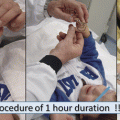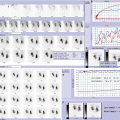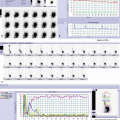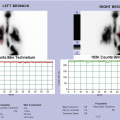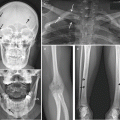© Springer International Publishing Switzerland 2017
Maria Carmen Garganese and Giovanni Francesco Livio D’Errico (eds.)Conventional Nuclear Medicine in Pediatrics10.1007/978-3-319-43181-9_33. Focus on Children with Nephrological and Urological Problems
(1)
Unit of Urology, “Bambino Gesù” Children Hospital, Rome, Italy
(2)
Unit of Nephrolgy, “Bambino Gesù” Children Hospital, Rome, Italy
3.1 Introduction
Pediatric urology in recent decades has made fundamental progress in the field of minimally invasive. The development of laparoscopic and endoscopic surgical techniques went hand in hand with the adoption of minimally invasive diagnostic methods.
Especially nuclear medicine and ultrasound have become the methods of choice for the diagnosis and management of urological problems of childhood, completely replacing the urography and limiting the use of other more invasive imaging studies.
The main advantage of nuclear medicine is the possibility of obtaining functional data, which are of fundamental importance in pediatric urology.
The studies of nuclear medicine do not require sedation, fasting, or bowel preparation. Rarely, urinary catheterization is necessary. These characteristics, in addition to the low dose of radiation, have contributed to the spread of these methods, generally performed on an outpatient basis.
3.1.1 Main Nuclear Medicine Procedures in Pediatric Urology
3.1.1.1 DMSA Scan
The DMSA renal scintigraphy is the preferred radiotracer for imaging of the renal cortex and has its main indication in the search of renal scarring. The radiopharmaceutical is closely linked to the renal tubules, providing the best visualization of the renal cortex without any interference due to dilatation of the renal pelvis. It also provides functional data correlated with GFR separately for each kidney. At some centers, DMSA scan is also used for the diagnosis of acute pyelonephritis [6]. Other indications are made by the confirmation of multicystic kidney, dysplasia, agenesis, or ectopia. Especially in the neonatal period, ultrasound may sometimes be insufficient to differentiate multicystic kidney from hydronephrosis; in these cases, renal scintigraphy can give a definitive answer. In case of ectopic kidneys, renal scintigraphy is also able to identify minimally functional parenchyma residues.
3.1.1.2 MAG3 Scan
MAG3 is the radiotracer of first choice currently utilized for dynamic renal scintigraphy in pediatric population. The sequential renal scintigraphy is the gold standard in the study of congenital abnormalities of the urinary tract.
The study, carried out according to clearly defined guidelines, provides useful information on separate renal functions (angiographic phase), the excretion and urinary drainage. In case of suspected urinary obstruction, the examination is supplemented by orthostatic and diuretic tests [5].
3.1.1.3 Radionuclide Cystography
Radionuclide cystography is an alternative to voiding cystourethrography (VCUG) for detection of vesicoureteral reflux (VUR). There are two distinct methods of radionuclide cystography: direct and indirect.
The direct radionuclide cystography, initially proposed by Winter in 1959 and modified by Conway in 1972, is performed instilling the radiopharmaceutical directly into the bladder [4, 14]. Reflux is identified when there is the appearance of radioactivity in the kidney and ureter. The indirect cystography is obtained at the end of the sequential renal scintigraphy. When the patient is asked to empty the bladder, reflux causes the reappearance of the radioactivity in the kidney and ureter.
3.1.2 Main Pediatric Nephrological and Urological Problems
3.1.2.1 Congenital Anomalies of the Kidney and Urinary Tract (CAKUTs) and Inherited Kidney Disease
CAKUTs occur in 3–6 per 1000 live births and are responsible for 34–59 % of chronic kidney disease (CKD) and for 31 % of all cases of end-stage kidney disease (ESKD) in children in the United States. All children with ESKD require renal replacement therapy, and up to 70 % of them develop hypertension. CAKUTs comprise a wide range of structural and functional malformations of renal system that occur at the level of the kidney (e.g., hypoplasia and dysplasia, horseshoe kidney, and renal agenesia), collecting system (e.g., hydronephrosis and megaureter), bladder (e.g., ureterocele and vesicoureteral reflux), or urethra (e.g., posterior urethral valves). With improved prenatal screening, many cases of CAKUT are diagnosed by antenatal ultrasonography performed on the fetus of 18–20 weeks of gestation. Most common antenatal manifestations of CAKUT include oligohydramnios or variations in gross morphology of the kidney, ureter, or bladder. Postnatal manifestations of CAKUT may include presence of palpable abdominal mass or single umbilical artery, feeding difficulties, decreased urine output, deficient abdominal wall musculature, and undescended testes in a male infant or multiorgan birth defects. Renal scintigraphy using DMSA is accepted for evaluating renal cortical damage associated with vesicoureteral reflux. Diuretic renography using MAG3 is widely accepted for evaluating differential renal function and/or the shape of the diuretic curve associated with obstructive uropathy. Renal scintigraphy is also a complementary imaging modality in the workup of patients with inherited kidney disease as polycystic kidney disease, tuberous sclerosis complex, medullary cystic kidney disease (MCKD), and nephronophthisis. DMSA is a highly sensitive tracer for detecting functioning renal cortical tissue, and there have been several reports about its utility in different forms of parenchymal and tubulointerstitial diseases.
3.1.2.2 Hydronephrosis
Generally, the ultrasound diagnosis of hydronephrosis has been known since prenatal age and, if it is confirmed in the first weeks of life, the question arises of whether this is due to a real stenosis of ureteropelvic junction. At our center, we perform the renal scintigraphy in cases of hydronephrosis with anteroposterior diameter greater than 15 mm, usually after 2 months of age. The renal scintigraphy provides useful information on whether the obstruction is significant (positive diuretic test) and if there is a decrease in kidney function. This information, supplemented by clinical and ultrasound (worsening of dilation?), let ultimately assess which patients need surgery or just conservative follow-up [11].
Stay updated, free articles. Join our Telegram channel

Full access? Get Clinical Tree




